Stapling a poster to a Saint-Viateur hydro pole
A Quebec Court of Appeal judge has ruled that Montreal’s anti-postering bylaw, which prohibits posters from being stuck to public street furniture, violates the Charter of Rights and Freedoms. Montreal will now have to find a way to legally accommodate posters on public property.
We have local activist Jaggi Singh to thank for this ruling. Ten years ago, he was charged with sticking a poster on municipal property, and with the help of civil rights lawyer Julius Grey, he took his case through the court system. He was finally acquitted last week. The implications for Montreal are profound: independent musicians, artists, community groups and political movements, who have faced thousands of dollars in fines for sticking posters on lampposts and hydro poles, are now free to do what they’ve been doing for years.
Bengali poster, Park Extension
It’s hard to overstate the advantages of postering. As a means of advertising, it’s cheap, direct and locally-targeted, which is perfect for anyone who doesn’t have much money and who is promoting something to a niche or neighbourhood audience. For a community group, sticking a poster on lamppost is a far more effective and equitable way of spreading a message than posting an item on an online discussion board.
Until now, the only place you could legally stick a poster was on a construction hoarding, a loophole in the law that was ruthlessly exploited by a single advertising firm, Publicité sauvage, which had spent years lobbying the city for just such an exception. With hoardings covered by large commercial posters for cars, soft drinks and big-ticket cultural events, everyone else was left to stick their posters on public property, which put them at risk for receiving a fine.
Legal postering space — dominated by one advertising firm
The sheer abundance of posters on streets like Saint-Viateur suggests that the law wasn’t very strictly enforced, but in recent years the city has become more aggressive in fining music promoters whose concerts are advertised on public property. According to a recent article in Hour, Montreal’s independent cultural producers have collectively been fined more than $215,000 over the past two years.
Now that the Court of Appeals has ruled Montreal’s postering law unconstitutional, the question is how the city will now accommodate postering on public property. One approach would be to create dedicated poster kiosks, a solution adopted by many cities around the world, including Paris, whose turn-of-the-century poster kiosks are as much as emblem of the city as Hector Guimard’s metro entrances. Another way would be to follow Vancouver, which puts casts around the its lampposts, providing legal postering space that is cleared every week by municipal workers.
A poster cast on a Vancouver lamppost
Or we could take the obvious route and just let things be. Posters already cover every piece of street furniture in the city, from traffic control boxes to mailboxes to bicycle racks to hydro poles.
At a time when more and more social activity takes place online and a majority of people live in car-dependent suburbs, posters are a flamboyant sign that pedestrian culture is still alive, that the streets are still the agora they were meant to be. If the city can refrain itself from passing a new law to regulate posters, if it can somehow find the will to just do nothing and let posters exist in a grey area, neither legal nor illegal — I think we would have the perfect solution to the problem.
UPDATE: Le Devoir is reporting that the city wants to install 500 “espaces d’affichage” on public property: “Ainsi, des modules circulaires de 22 pouces de diamètres, un peu comme un moulin à prières utilisé par les bouddhistes tibétains, fixés à des poteaux ou des lampadaires, permettraient d’agrafer des affiches de 11 sur 17 pouces.”
La Presse has more details on the city’s plan. It also reports that the city will continue to enforce its law until it decides whether to challenge the court’s decision.
Jack Dylan concert poster, Mile End
Promoting a show by Moroccan actress Khadija Assad, Villeray
Schach for sukkot, Mile End

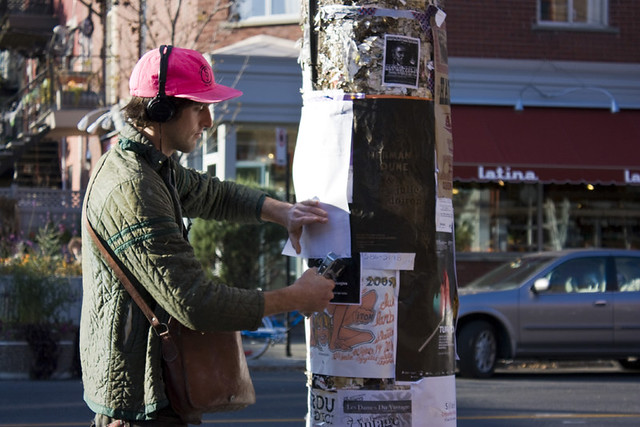
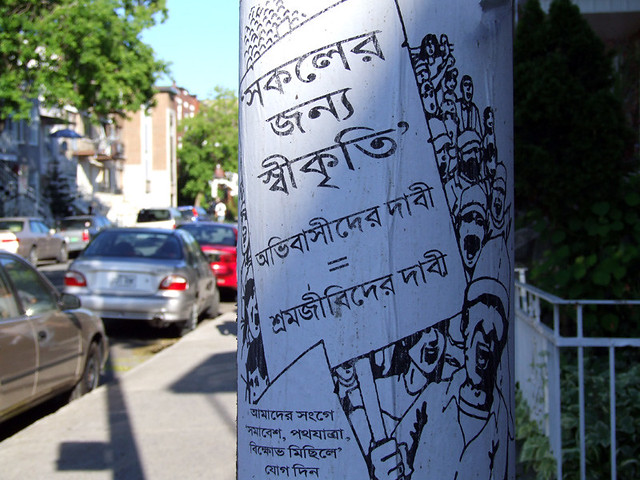
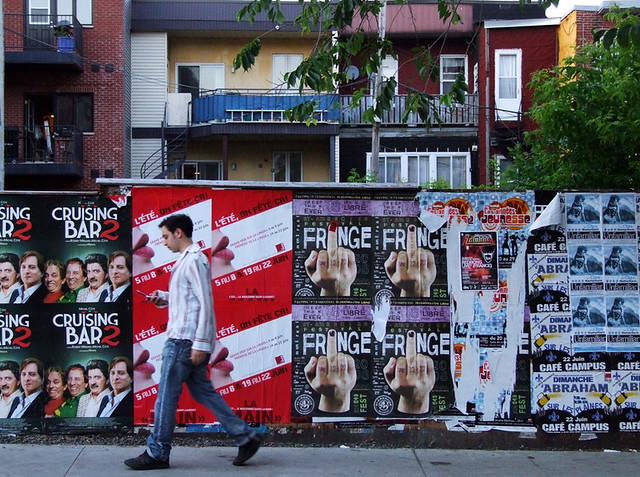
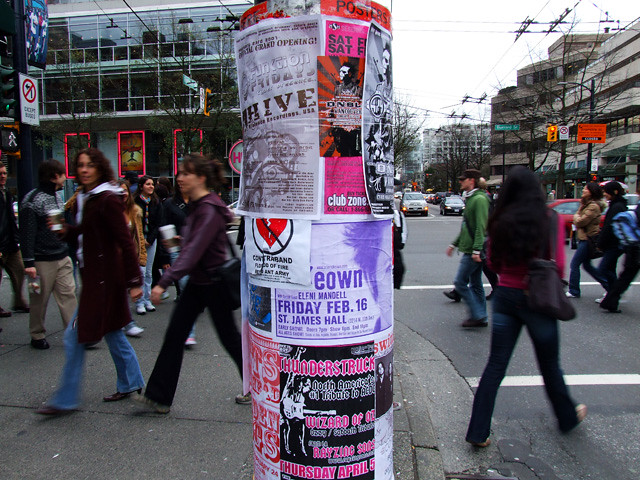
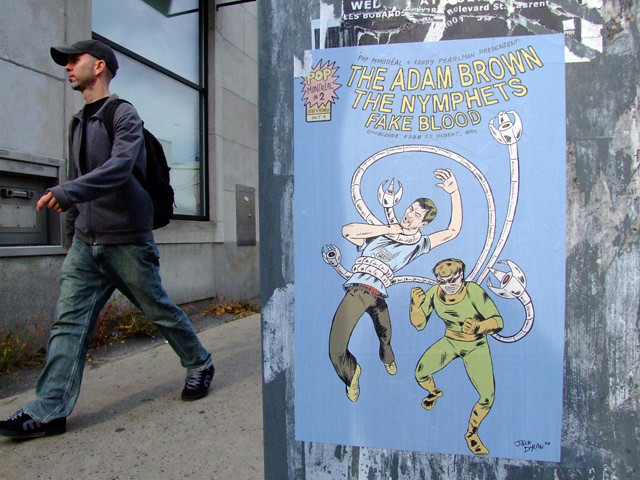
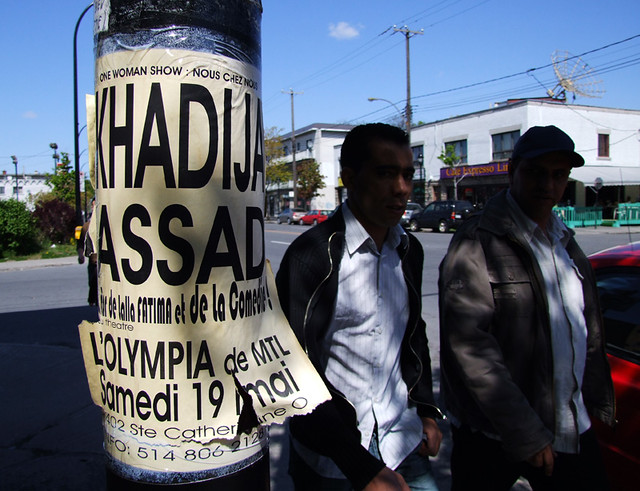

9 comments
Great news!
“the city will continue to enforce its law until it decides whether to challenge the court’s decision.” -> OK, I’m not a lawyer, but… The article starts by saying this bylaw violates a higher law. So how can the city continue to enforce something illegal?
There’s a big difference between advertising for activities organised by for-profit companies and non-profit groups or collectives of people wanting to communicate their views or advertise their events.
Those rushing in to welcome this broad new regulation may find that, rather than supporting the kind of posters generated by the wild-cat turn-a-blind-eye activities that make Montreal posters eclectic and interesting, it may make our cityscape horrendously bland space full of junky corporate publicité.
By the way, has anyone else noticed the horrendous Nike ad spray painted onto the pavement on McGill College Avenue. It’s revolting, and I consider it vandalism.
Is it just me? I think these faded posters stuck to every mailbox and lamp post make the city look tatty, dirty and run down. Other cities (such as Vancouver) seem to have eliminated the practice and look much better.
Question – does this apply to posters stuck on private property? When does freedom of expression come into conflict with private property? And do corporate entities also have a right to free expression?
cultural enrichment, or just eyesore? I don’t mind posters, but you gotta take them down afterwards, just like cleaning your room and doing your laundry and cleaning the dishes, no body likes to do it, but you gotta do it.
I agree with Alf – Milton St. in particular is a real disaster area at the moment, in terms of old and scrappy posters half falling off walls, poles and Canada Post boxes. I’m half tempted to just go down there with a scrapper and fix it up myself.
What I’m hoping is the City will agree with the regulation, on the understanding that it is legal to post provided that you don’t physically damage the structure underneath – i.e., that the poster must be easy to remove. I note that posters that are taped up fit this criteria – the ones that are pasted to things look awful.
Doing nothing to regulate it makes for messier streetscapes where it is prevalent. In areas with a lot of postering in Toronto, those postering will move from poles to street furniture as the poles run out of space. Sometimes on windy and rainy days, chunks of posters fall off the poles.
It sounds as though the situation in Montreal is similar. I can’t help but think that some regulation is necessary to clean things up but still allow for posters.
I read in the Gazette this morning that the Plateau borough has banned the installation of new billboards in its area (this ban won’t affect existing billboards). Bye bye to new billboard blight.
http://www.montrealgazette.com/Little+opposition+Plateau+billboard/3330696/story.html